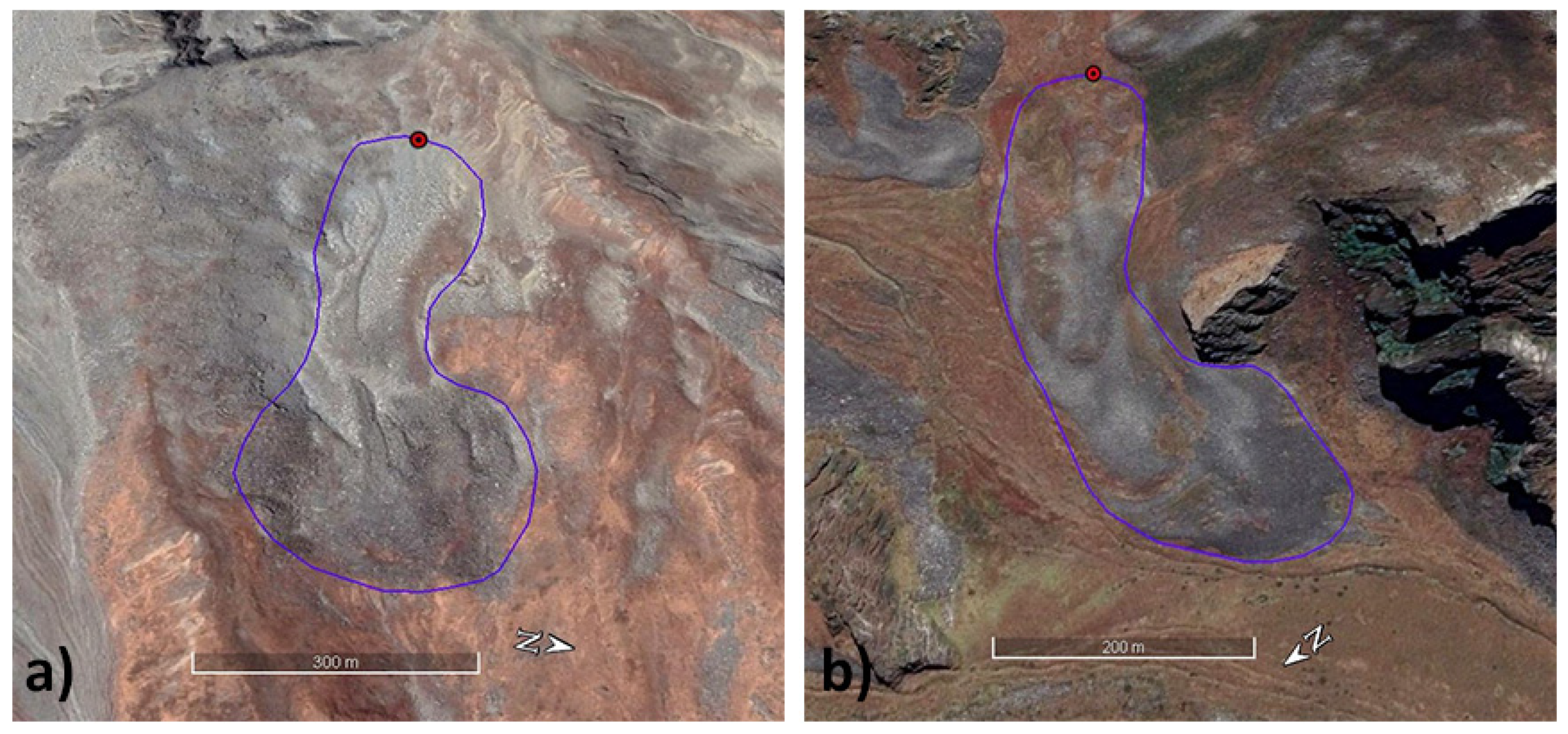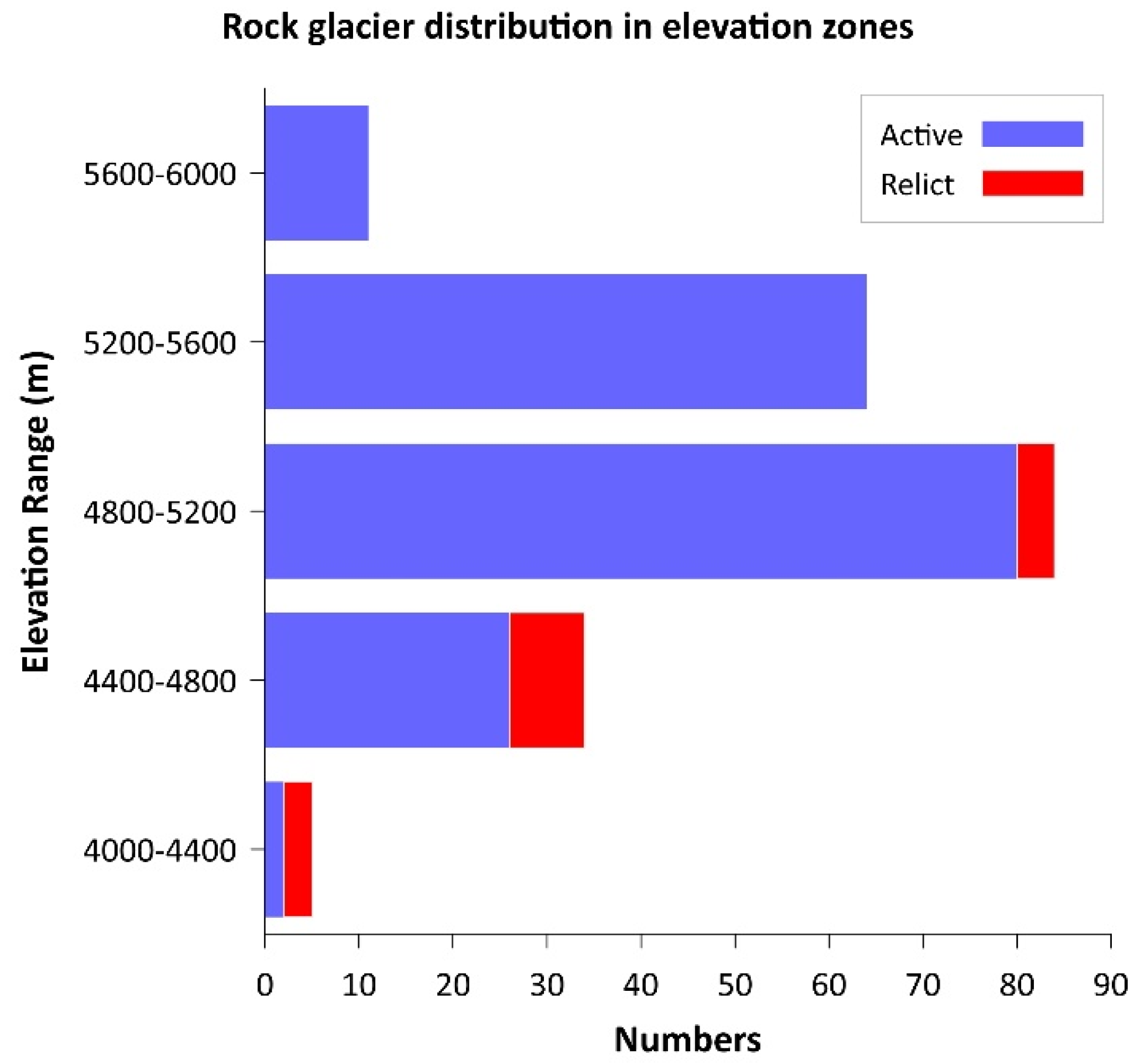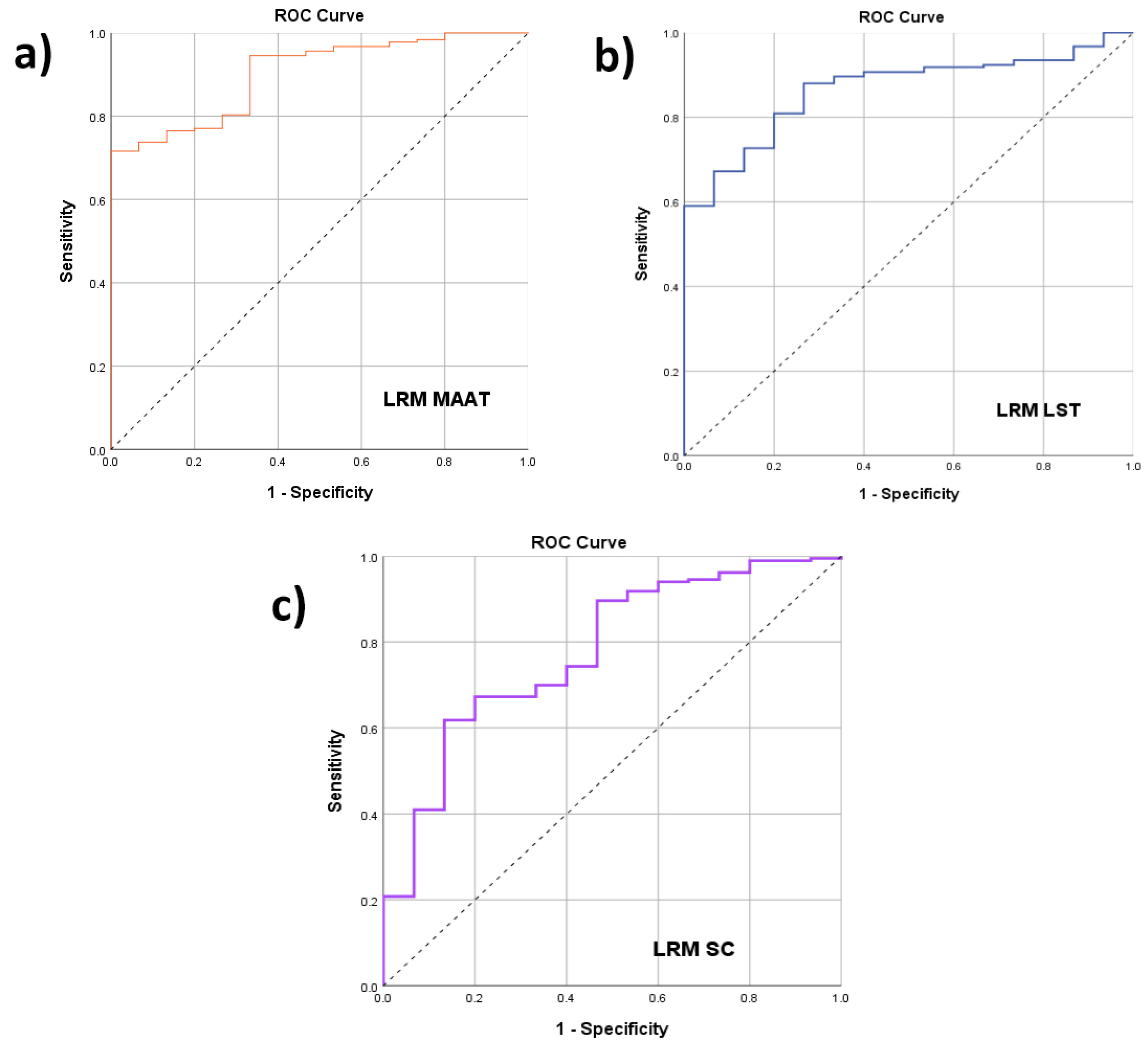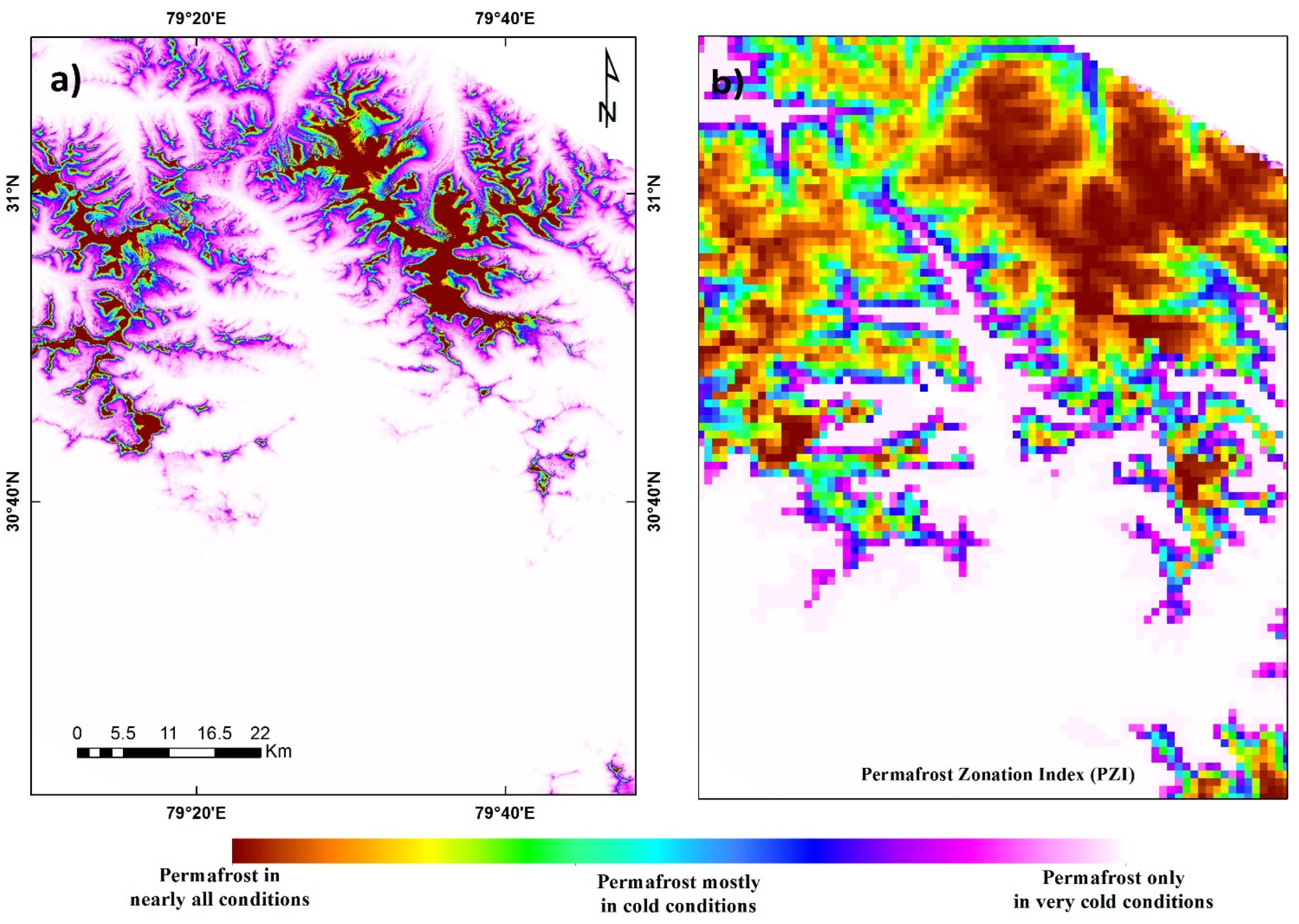Modeling Permafrost Distribution Using Geoinformatics in the Alaknanda Valley, Uttarakhand, India
Abstract
1. Introduction
2. Study Area
3. Materials and Methods
3.1. Data Used
3.2. Predictor Variables
3.2.1. Mean Annual Air Temperature (MAAT)
3.2.2. Land Surface Temperature (LST)
3.2.3. Snow Cover
3.2.4. Potential Incoming Solar Radiation (PISR)
3.2.5. Aspect
3.3. Methodology
3.3.1. Identification and Mapping of Rock Glaciers
3.3.2. Logistic Regression Model
4. Results
4.1. Rock Glacier Compilation
4.2. Logistic Regression Models
4.3. Permafrost Distribution Map Interpretation
5. Discussion
6. Conclusions
Author Contributions
Funding
Institutional Review Board Statement
Informed Consent Statement
Data Availability Statement
Acknowledgments
Conflicts of Interest
References
- French, H.M. The Periglacial Environment, 4th ed.; John Wiley & Sons: Hoboken, NJ, USA, 2017; ISBN 978-1-119-13278-3. [Google Scholar]
- Kitover, D.C.; van Balen, R.T.; Vandenberghe, J.; Roche, D.M.; Renssen, H. LGM Permafrost Thickness and Extent in the Northern Hemisphere Derived from the Earth System Model i LOVECLIM: LGM Permafrost Thickness and Extent Using i LOVECLIM. Permafr. Periglac. Process. 2016, 27, 31–42. [Google Scholar] [CrossRef]
- Li, Y.; Conway, D.; Xiong, W.; Gao, Q.; Wu, Y.; Wan, Y.; Li, Y.; Zhang, S. Effects of Climate Variability and Change on Chinese Agriculture: A Review. Clim. Res. 2011, 50, 83–102. [Google Scholar] [CrossRef]
- Boike, J.; Juszak, I.; Lange, S.; Chadburn, S.; Burke, E.; Overduin, P.P.; Roth, K.; Ippisch, O.; Bornemann, N.; Stern, L.; et al. A 20-Year Record (1998–2017) of Permafrost, Active Layer and Meteorological Conditions at a High Arctic Permafrost Research Site (Bayelva, Spitsbergen). Earth Syst. Sci. Data 2018, 10, 355–390. [Google Scholar] [CrossRef]
- Cao, B.; Zhang, T.; Wu, Q.; Sheng, Y.; Zhao, L.; Zou, D. Permafrost Zonation Index Map and Statistics over the Qinghai-Tibet Plateau Based on Field Evidence. Permafr. Periglac. Process. 2019, 30, 178–194. [Google Scholar] [CrossRef]
- IPCC. The Ocean and Cryosphere in a Changing Climate: Special Report of the Intergovernmental Panel on Climate Change, 1st ed.; Cambridge University Press: Cambridge, UK, 2022; ISBN 978-1-00-915796-4.
- Haeberli, W.; Guodong, C.; Gorbunov, A.P.; Harris, S.A. Mountain Permafrost and Climatic Change. Permafr. Periglac. Process. 1993, 4, 165–174. [Google Scholar] [CrossRef]
- Harris, C.; Arenson, L.U.; Christiansen, H.H.; Etzelmüller, B.; Frauenfelder, R.; Gruber, S.; Haeberli, W.; Hauck, C.; Hölzle, M.; Humlum, O.; et al. Permafrost and Climate in Europe: Monitoring and Modelling Thermal, Geomorphological and Geotechnical Responses. Earth-Sci. Rev. 2009, 92, 117–171. [Google Scholar] [CrossRef]
- Yang, M.; Nelson, F.E.; Shiklomanov, N.I.; Guo, D.; Wan, G. Permafrost Degradation and Its Environmental Effects on the Tibetan Plateau: A Review of Recent Research. Earth-Sci. Rev. 2010, 103, 31–44. [Google Scholar] [CrossRef]
- Shugar, D.H.; Jacquemart, M.; Shean, D.; Bhushan, S.; Upadhyay, K.; Sattar, A.; Schwanghart, W.; McBride, S.; de Vries, M.V.W.; Mergili, M.; et al. A Massive Rock and Ice Avalanche Caused the 2021 Disaster at Chamoli, Indian Himalaya. Science 2021, 373, 300–306. [Google Scholar] [CrossRef]
- Das, S.; Sarkar, S.; Kanungo, D.P. A Critical Review on Landslide Susceptibility Zonation: Recent Trends, Techniques, and Practices in Indian Himalaya. Nat. Hazards 2022. [Google Scholar] [CrossRef]
- Parida, B.; Behera, S.; Bakimchandra, O.; Pandey, A.; Singh, N. Evaluation of Satellite-Derived Rainfall Estimates for an Extreme Rainfall Event over Uttarakhand, Western Himalayas. Hydrology 2017, 4, 22. [Google Scholar] [CrossRef]
- Singh, N.; Shekhar, M.; Parida, B.R.; Gupta, A.K.; Sain, K.; Rai, S.K.; Bräuning, A.; Singh Charkaborty, J.; Sharma, V.; Kamal Tiwari, R.; et al. Tree-Ring Isotopic Records Suggest Seasonal Importance of Moisture Dynamics Over Glacial Valleys of the Central Himalaya. Front. Earth Sci. 2022, 10, 868357. [Google Scholar] [CrossRef]
- Barsch, D. Rockglaciers: Indicators for the Present and Former Geoecology in High Mountain Environments; Springer Series in Physical Environment; Springer: Berlin, Germany; New York, NY, USA, 1996; ISBN 978-3-540-60742-7. [Google Scholar]
- Haeberli, W.; Hallet, B.; Arenson, L.; Elconin, R.; Humlum, O.; Kääb, A.; Kaufmann, V.; Ladanyi, B.; Matsuoka, N.; Springman, S.; et al. Permafrost Creep and Rock Glacier Dynamics. Permafr. Periglac. Process. 2006, 17, 189–214. [Google Scholar] [CrossRef]
- Barsch, D. Permafrost Creep and Rockglaciers. Permafr. Periglac. Process. 1992, 3, 175–188. [Google Scholar] [CrossRef]
- Frehner, M.; Ling, A.H.M.; Gärtner-Roer, I. Furrow-and-Ridge Morphology on Rockglaciers Explained by Gravity-Driven Buckle Folding: A Case Study From the Murtèl Rockglacier (Switzerland): Rockglacier Furrow-and-Ridge Morphology Explained by Buckle Folding. Permafr. Periglac. Process. 2015, 26, 57–66. [Google Scholar] [CrossRef]
- Azam, M.F.; Ramanathan, A.; Wagnon, P.; Vincent, C.; Linda, A.; Berthier, E.; Sharma, P.; Mandal, A.; Angchuk, T.; Singh, V.B.; et al. Meteorological Conditions, Seasonal and Annual Mass Balances of Chhota Shigri Glacier, Western Himalaya, India. Ann. Glaciol. 2016, 57, 328–338. [Google Scholar] [CrossRef]
- Sood, V.; Tiwari, R.K.; Singh, S.; Kaur, R.; Parida, B.R. Glacier Boundary Mapping Using Deep Learning Classification over Bara Shigri Glacier in Western Himalayas. Sustainability 2022, 14, 13485. [Google Scholar] [CrossRef]
- Jain, S.K.; Mir, R.A. Glacier and Glacial Lake Classification for Change Detection Studies Using Satellite Data: A Case Study from Baspa Basin, Western Himalaya. Geocarto Int. 2019, 34, 391–414. [Google Scholar] [CrossRef]
- Akhtar, M.; Ahmad, N.; Booij, M.J. The Impact of Climate Change on the Water Resources of Hindukush–Karakorum–Himalaya Region under Different Glacier Coverage Scenarios. J. Hydrol. 2008, 355, 148–163. [Google Scholar] [CrossRef]
- Bhambri, R.; Bolch, T.; Chaujar, R.K.; Kulshreshtha, S.C. Glacier Changes in the Garhwal Himalaya, India, from 1968 to 2006 Based on Remote Sensing. J. Glaciol. 2011, 57, 543–556. [Google Scholar] [CrossRef]
- Azócar, G.F.; Brenning, A.; Bodin, X. Permafrost Distribution Modelling in the Semi-Arid Chilean Andes. Cryosphere 2017, 11, 877–890. [Google Scholar] [CrossRef]
- Marcer, M.; Bodin, X.; Brenning, A.; Schoeneich, P.; Charvet, R.; Gottardi, F. Permafrost Favorability Index: Spatial Modeling in the French Alps Using a Rock Glacier Inventory. Front. Earth Sci. 2017, 5, 105. [Google Scholar] [CrossRef]
- Sattler, K.; Anderson, B.; Mackintosh, A.; Norton, K.; de Róiste, M. Estimating Permafrost Distribution in the Maritime Southern Alps, New Zealand, Based on Climatic Conditions at Rock Glacier Sites. Front. Earth Sci. 2016, 4, 4. [Google Scholar] [CrossRef]
- Zhang, Z.; Wang, M.; Wu, Z.; Liu, X. Permafrost Deformation Monitoring Along the Qinghai-Tibet Plateau Engineering Corridor Using InSAR Observations with Multi-Sensor SAR Datasets from 1997–2018. Sensors 2019, 19, 5306. [Google Scholar] [CrossRef] [PubMed]
- Gruber, S.; Fleiner, R.; Guegan, E.; Panday, P.; Schmid, M.-O.; Stumm, D.; Wester, P.; Zhang, Y.; Zhao, L. Review Article: Inferring Permafrost and Permafrost Thaw in the Mountains of the Hindu Kush Himalaya Region. Cryosphere 2017, 11, 81–99. [Google Scholar] [CrossRef]
- Hassan, J.; Chen, X.; Muhammad, S.; Bazai, N.A. Rock Glacier Inventory, Permafrost Probability Distribution Modeling and Associated Hazards in the Hunza River Basin, Western Karakoram, Pakistan. Sci. Total Environ. 2021, 782, 146833. [Google Scholar] [CrossRef] [PubMed]
- Schmid, M.-O.; Baral, P.; Gruber, S.; Shahi, S.; Shrestha, T.; Stumm, D.; Wester, P. Assessment of Permafrost Distribution Maps in the Hindu Kush Himalayan Region Using Rock Glaciers Mapped in Google Earth. Cryosphere 2015, 9, 2089–2099. [Google Scholar] [CrossRef]
- Baral, P.; Haq, M.A.; Yaragal, S. Assessment of Rock Glaciers and Permafrost Distribution in Uttarakhand, India. Permafr. Periglac. Process. 2020, 31, 31–56. [Google Scholar] [CrossRef]
- Allen, S.K.; Fiddes, J.; Linsbauer, A.; Randhawa, S.S.; Saklani, B.; Salzmann, N. Permafrost Studies in Kullu District, Himachal Pradesh. Curr. Sci. 2016, 111, 550. [Google Scholar] [CrossRef]
- Haq, M.A.; Baral, P. Study of Permafrost Distribution in Sikkim Himalayas Using Sentinel-2 Satellite Images and Logistic Regression Modelling. Geomorphology 2019, 333, 123–136. [Google Scholar] [CrossRef]
- Khan, M.A.R.; Singh, S.; Pandey, P.; Bhardwaj, A.; Ali, S.N.; Chaturvedi, V.; Ray, P.K.C. Modelling Permafrost Distribution in Western Himalaya Using Remote Sensing and Field Observations. Remote Sens. 2021, 13, 4403. [Google Scholar] [CrossRef]
- Gruber, S. Derivation and Analysis of a High-Resolution Estimate of Global Permafrost Zonation. Cryosphere 2012, 6, 221–233. [Google Scholar] [CrossRef]
- Obu, J.; Westermann, S.; Bartsch, A.; Berdnikov, N.; Christiansen, H.H.; Dashtseren, A.; Delaloye, R.; Elberling, B.; Etzelmüller, B.; Kholodov, A.; et al. Northern Hemisphere Permafrost Map Based on TTOP Modelling for 2000–2016 at 1 Km2 Scale. Earth-Sci. Rev. 2019, 193, 299–316. [Google Scholar] [CrossRef]
- Ali, S.N.; Quamar, M.; Phartiyal, B.; Sharma, A. Need for Permafrost Researches in Indian Himalaya. J. Clim. Chang. 2018, 4, 33–36. [Google Scholar] [CrossRef]
- Fick, S.E.; Hijmans, R.J. WorldClim 2: New 1-km Spatial Resolution Climate Surfaces for Global Land Areas. Int. J. Climatol. 2017, 37, 4302–4315. [Google Scholar] [CrossRef]
- Zhengming, W.; Simon, H.; Glynn, H. MODIS/Terra Land Surface Temperature/Emissivity 8-Day L3 Global 1km SIN Grid V061. 2021. Available online: https://lpdaac.usgs.gov/products/mod11a2v006/ (accessed on 4 June 2022).
- Hall, D.K.; Riggs, G.A.; Solomonson, V. NASA MODAPS SIPS MODIS/Terra Snow Cover Daily L3 Global 500 m SIN Grid. 2015. Available online: https://nsidc.org/data/mod10a1/versions/6 (accessed on 2 June 2022).
- NASA/METI/AIST/Japan Spacesystems and U.S./Japan ASTER Science Team ASTER Global Digital Elevation Model V003. 2019. Available online: https://lpdaac.usgs.gov/products/astgtmv003/ (accessed on 7 June 2022).
- Earth Resources Observation and Science (EROS) Center Global 30 Arc-Second Elevation (GTOPO30). 2017. Available online: https://earthexplorer.usgs.gov/ (accessed on 4 June 2022).
- Hachem, S.; Allard, M.; Duguay, C. Using the MODIS Land Surface Temperature Product for Mapping Permafrost: An Application to Northern Québec and Labrador, Canada: Using the MODIS Land Surface Temperature Product for Mapping Permafrost. Permafr. Periglac. Process. 2009, 20, 407–416. [Google Scholar] [CrossRef]
- Westermann, S.; Langer, M.; Boike, J. Spatial and Temporal Variations of Summer Surface Temperatures of High-Arctic Tundra on Svalbard—Implications for MODIS LST Based Permafrost Monitoring. Remote Sens. Environ. 2011, 115, 908–922. [Google Scholar] [CrossRef]
- Yin, G.; Zheng, H.; Niu, F.; Luo, J.; Lin, Z.; Liu, M. Numerical Mapping and Modeling Permafrost Thermal Dynamics across the Qinghai-Tibet Engineering Corridor, China Integrated with Remote Sensing. Remote Sens. 2018, 10, 2069. [Google Scholar] [CrossRef]
- Guglielmin, M.; Aldighieri, B.; Testa, B. PERMACLIM: A Model for the Distribution of Mountain Permafrost, Based on Climatic Observations. Geomorphology 2003, 51, 245–257. [Google Scholar] [CrossRef]
- Hall, D.K.; Riggs, G.A. Normalized-Difference Snow Index (NDSI). In Encyclopedia of Snow, Ice and Glaciers; Singh, V.P., Singh, P., Haritashya, U.K., Eds.; Encyclopedia of Earth Sciences Series; Springer: Dordrecht, The Netherlands, 2011; pp. 779–780. ISBN 978-90-481-2641-5. [Google Scholar]
- Martin, H. Permafrost und Gletscher im Oberengadin: Grundlagen und Anwendungsbeispiele für automatisierte Schätzverfahren; ETH: Zurich, Switzerland, 1994; p. 130S. [Google Scholar]
- Bharti, R.R.; Adhikari, B.S.; Rawat, G.S. Assessing Vegetation Changes in Timberline Ecotone of Nanda Devi National Park, Uttarakhand. Int. J. Appl. Earth Obs. Geoinf. 2012, 18, 472–479. [Google Scholar] [CrossRef]
- Maheshwari, A. Snow Leopard (Panthera Uncia) Surveys in the Western Himalayas, India. J. Ecol. Nat. Environ. 2013, 5, 303–309. [Google Scholar] [CrossRef]
- López-Moreno, J.I.; Revuelto, J.; Gilaberte, M.; Morán-Tejeda, E.; Pons, M.; Jover, E.; Esteban, P.; García, C.; Pomeroy, J.W. The Effect of Slope Aspect on the Response of Snowpack to Climate Warming in the Pyrenees. Theor. Appl. Climatol. 2014, 117, 207–219. [Google Scholar] [CrossRef]
- Kääb, A.; Weber, M. Development of Transverse Ridges on Rock Glaciers: Field Measurements and Laboratory Experiments: Transverse Ridges on Rock Glaciers. Permafr. Periglac. Process. 2004, 15, 379–391. [Google Scholar] [CrossRef]
- Baroni, C.; Carton, A.; Seppi, R. Distribution and Behaviour of Rock Glaciers in the Adamello–Presanella Massif (Italian Alps). Permafr. Periglac. Process. 2004, 15, 243–259. [Google Scholar] [CrossRef]
- Potter, N., Jr.; Steig, E.J.; Clark, D.H.; Speece, M.A.; Clark, G.M.; Updike, A.B. Galena Creek Rock Glacier Revisited—New Observations on an Old Controversy. Geogr. Ann. Ser. Phys. Geogr. 1998, 80, 251–265. [Google Scholar] [CrossRef]
- Janke, J.R.; Regmi, N.R.; Giardino, J.R.; Vitek, J.D. 8.17 Rock Glaciers. In Treatise on Geomorphology; Elsevier: Amsterdam, The Netherlands, 2013; pp. 238–273. ISBN 978-0-08-088522-3. [Google Scholar]
- Wahrhaftig, C.; Cox, A. Rock Glaciers in the Alaska Range. Geol. Soc. Am. Bull. 1959, 70, 383. [Google Scholar] [CrossRef]
- Bodin, X.; Schoeneich, P.; Deline, P.; Ravanel, L.; Magnin, F.; Krysiecki, J.-M.; Echelard, T. Mountain Permafrost and Associated Geomorphological Processes: Recent Changes in the French Alps. Rev. Géographie Alp. 2015, 103, 1–17. [Google Scholar] [CrossRef]
- Boeckli, L.; Brenning, A.; Gruber, S.; Noetzli, J. A Statistical Approach to Modelling Permafrost Distribution in the European Alps or Similar Mountain Ranges. Cryosphere 2012, 6, 125–140. [Google Scholar] [CrossRef]
- Peng, C.-Y.J.; So, T.-S.H. Logistic Regression Analysis and Reporting: A Primer. Underst. Stat. 2002, 1, 31–70. [Google Scholar] [CrossRef]
- Hosmer, D.W.; Lemeshow, S.; Sturdivant, R.X. Applied Logistic Regression, 3rd ed.; Wiley series in probability and statistics; Wiley: Hoboken, NJ, USA, 2013; ISBN 978-1-118-54838-7. [Google Scholar]
- Zhang, T. Influence of the Seasonal Snow Cover on the Ground Thermal Regime: An Overview: Snow Cover and Ground Thermal Regime. Rev. Geophys. 2005, 43, RG4002. [Google Scholar] [CrossRef]
- Hrbáček, F.; Engel, Z.; Kňažková, M.; Smolíková, J. Effect of Ephemeral Snow Cover on the Active Layer Thermal Regime Andthickness on CALM-S JGM Site, James Ross Island, Eastern Antarctic Peninsula; Frozen Ground/Antarctic: Gottingten, Germany, 2021. [Google Scholar]
- Gao, H.; Nie, N.; Zhang, W.; Chen, H. Monitoring the Spatial Distribution and Changes in Permafrost with Passive Microwave Remote Sensing. ISPRS J. Photogramm. Remote Sens. 2020, 170, 142–155. [Google Scholar] [CrossRef]
- Wang, J.; Jiang, L.; Wu, S.; Zhang, C.; Chen, Y.; Li, H.; Yang, J.; Pan, F.; Cui, H. Land Surface Freeze/Thaw Detection Over the Qinghai–Tibet Plateau Using FY-3/MWRI Data. IEEE Trans. Geosci. Remote Sens. 2022, 60, 4305017. [Google Scholar] [CrossRef]
- Philipp, M.; Dietz, A.; Buchelt, S.; Kuenzer, C. Trends in Satellite Earth Observation for Permafrost Related Analyses—A Review. Remote Sens. 2021, 13, 1217. [Google Scholar] [CrossRef]










| Dataset Used | Spatial/Temporal Resolution | Purpose | Source |
|---|---|---|---|
| WorldClim Average Temperature | ~1 km/monthly | to develop MAAT layer | [37] |
| MODIS LST | 1 km/8 days | to develop mean LST layer | [38] |
| MODIS Snow Cover | 500 m/daily | to develop mean snow cover layer | [39] |
| ASTER GDEM | 30 m/NA | to develop PISR and aspect layers | [40] |
| GTOPO 30 | ~1 km/NA | to develop MAAT layer | [41] |
| Geomorphic Indicators | Active | Relict |
|---|---|---|
| Surface structure | Prominent furrow and ridge topography [51] | Less prominent furrow and ridge topography [51] |
| Body | Bulged swollen structure [52] Exposure of ice on the surface in some places [53] | Flat and subdued surface topography [52] Deflated surface feature [54] |
| Frontal Lobe | Sharp-crested frontal lobe slope [55] | Gentle transition from frontal lobe to body [55] |
| 95% Confidence Interval of Bz | ||||||
|---|---|---|---|---|---|---|
| Bz | Bias (°C) | SE (°C) | p-value | Lower | Upper | |
| MAAT | −0.777 | −0.072 | 0.212 | 0.001 | −1.325 | −0.540 |
| PISR | −0.001 | 0.000 | 0.003 | 0.006 | −0.004 | 0.005 |
| Aspect | 0.004 | 0.001 | 0.008 | 0.089 | −0.001 | 0.013 |
| Constant | 7.689 | 0.022 | 1.295 | 0.004 | 4.321 | 11.754 |
| 95% Confidence Interval of Bz | ||||||
|---|---|---|---|---|---|---|
| Bz | Bias (°C) | SE (°C) | p-value | Lower | Upper | |
| LST | −0.706 | −0.048 | 0.143 | 0.001 | −0.987 | −0.350 |
| PISR | −0.002 | 0.000 | 0.002 | 0.004 | −0.003 | 0.005 |
| Aspect | 0.001 | 0.000 | 0.005 | 0.064 | −0.005 | 0.010 |
| Constant | 3.231 | 0.063 | 0.998 | 0.001 | 1.343 | 6.154 |
| 95% Confidence Interval of Bz | ||||||
|---|---|---|---|---|---|---|
| Bz | Bias | SE | p-value | Lower | Upper | |
| Snow Cover | 0.789 | 0.009 | 0.054 | 0.001 | 0.312 | 0.956 |
| PISR | −0.001 | 0.000 | 0.002 | 0.005 | −0.003 | 0.005 |
| Aspect | 0.003 | 0.001 | 0.005 | 0.038 | 0.053 | 0.266 |
| Constant | 3.514 | 0.106 | 1.872 | 0.028 | 0.438 | 6.327 |
| Asymptotic 95% Confidence Interval | |||||
|---|---|---|---|---|---|
| Model | Area | Std. Error | Asymptotic Sig. | Lower Bound | Upper Bound |
| LRM-MAAT | 0.902 | 0.030 | 0.000 | 0.843 | 0.962 |
| LRM-LST | 0.866 | 0.034 | 0.000 | 0.798 | 0.933 |
| LRM-SC | 0.777 | 0.061 | 0.000 | 0.657 | 0.897 |
Publisher’s Note: MDPI stays neutral with regard to jurisdictional claims in published maps and institutional affiliations. |
© 2022 by the authors. Licensee MDPI, Basel, Switzerland. This article is an open access article distributed under the terms and conditions of the Creative Commons Attribution (CC BY) license (https://creativecommons.org/licenses/by/4.0/).
Share and Cite
Pandey, A.C.; Ghosh, T.; Parida, B.R.; Dwivedi, C.S.; Tiwari, R.K. Modeling Permafrost Distribution Using Geoinformatics in the Alaknanda Valley, Uttarakhand, India. Sustainability 2022, 14, 15731. https://doi.org/10.3390/su142315731
Pandey AC, Ghosh T, Parida BR, Dwivedi CS, Tiwari RK. Modeling Permafrost Distribution Using Geoinformatics in the Alaknanda Valley, Uttarakhand, India. Sustainability. 2022; 14(23):15731. https://doi.org/10.3390/su142315731
Chicago/Turabian StylePandey, Arvind Chandra, Tirthankar Ghosh, Bikash Ranjan Parida, Chandra Shekhar Dwivedi, and Reet Kamal Tiwari. 2022. "Modeling Permafrost Distribution Using Geoinformatics in the Alaknanda Valley, Uttarakhand, India" Sustainability 14, no. 23: 15731. https://doi.org/10.3390/su142315731
APA StylePandey, A. C., Ghosh, T., Parida, B. R., Dwivedi, C. S., & Tiwari, R. K. (2022). Modeling Permafrost Distribution Using Geoinformatics in the Alaknanda Valley, Uttarakhand, India. Sustainability, 14(23), 15731. https://doi.org/10.3390/su142315731








